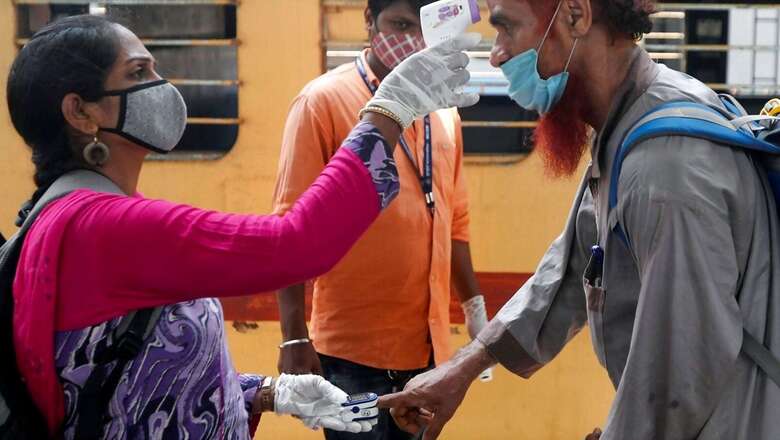
views
There may be confusion over whether India has detected its first XE Covid case, but there’s no doubt about the existence of the new recombinant variant of the novel coronavirus. Mumbai might have reported the first case of the XE recombinant, but the INSACOG has denied its presence after genome sequencing.
First detected in the United Kingdom, the new Omicron strain is known to be more transmissible than any previous strain, as per the World Health Organization.
Scientists are still studying XE, determining how it is different from previous Omicron strains such as the dominant BA.2 sub-variant, or even the lethal Delta variant that caused large-scale deaths in India last year.
XE is a recombinant variant. What does that mean?
First detected in the UK on January 19, the XE variant is a recombinant. This means it is a combination of Omicron (BA.1) and its subtype BA.2. A recombinant strain means that it is a mutant hybrid of the two previous versions of the Omicron variant, BA.1 and BA.2. Professor Susan Hopkins, chief medical adviser of UK Health Security Agency (UKHSA), said such variants were known as recombinant and usually died off “relatively quickly”.
In its latest update, the WHO said the new strain is known as the XE recombinant (BA.1-BA.2). According to the UKHSA, XE is also being called a stealth variant because of its ability to evade detection. This characteristic was also reported with the original strain BA.1 and its subtype BA.2. The WHO has said it more transmissible than any previous strain. As of March 16, XE had a growth rate 9.8 per cent above that of BA.2, the UKHSA said.
How is XE different from Omicron and Delta?
While the WHO has stated that XE is more transmissible than any previous strain, it is still contributing to relatively lower cases in its country of origin. But, the WHO has warned that it has the potential to become the predominant strain. It is 10 per cent more transmissible than other mutations.
Scientists have said XE belongs to the Omicron variant until significant differences in transmission and disease characteristics, including severity, may be reported. There was no evidence yet that XE was any more serious in disease severity, with all Omicron variants so far shown to be less severe, the WHO said.
Hopkins, too, said, “So far there is not enough evidence to draw conclusions about transmissibility, severity or vaccine effectiveness.”
The Omicron variant is fuelling China’s biggest wave since Wuhan’s initial outbreak in 2020. Classified as a variant of concern (VoC) when it was first detected in South Africa and Botswana, it quickly outcompeted the devastating Delta variant due to its “high transmissibility”. The Omicron variant was also responsible for India’s third wave in January.
But, health officials in China, too, have found a suspected new subtype of the Omicron variant in the Shanghai area. Officials in Suzhou, a city 30 minutes west of Shanghai, have detected a mutation not found in local or international databases. “This means a new variant of Omicron has been discovered locally,” Xinhua said, citing health official Zhang Jun, deputy director of the Suzhou Center for Disease Control and Prevention. The new iteration of the virus evolves from the BA.1.1 branch of Omicron.
The sub-variant BA.2, however, is spreading really fast seeing as it became the dominant strain in March. It is behind a surge in coronavirus cases in countries such as the UK. The original strain became predominant due to its high transmissibility, as the mutations on the virus’s spike protein, the part that attaches to human cells, are believed to increase the probability of infection. Its effective and enhanced transmissibility comes from its ability to evade immunity.
While Omicron is known to spread faster than Delta, the variant is less severe. Delta (B.1.617.2), meanwhile, proved to be lethal leading to large-scale deaths and hospitalisations. It was first identified in India in late 2020 and soon spread throughout the world becoming a predominant version until Omicron took its place in mid-December. It caused India’s devastating second wave in April last year, sparking a severe oxygen shortage in national capital Delhi. The Delta variant was associated with lung infection often leading to a need for oxygen. It also caused more severe disease in those who had not been vaccinated. Omicron, meanwhile, has been associated with infecting the upper respiratory tract and less severe symptoms.
What is the status on XE?
The UKHSA is studying the recombinant and, as of March 22, the agency has detected 637 XE cases in England, according to official figures. The agency, however, warned that “as this estimate has not remained consistent as new data have been added, it cannot yet be interpreted as an estimate of growth advantage for the recombinant”.
“Numbers were too small for the XE recombinant to be analysed by region,” the UKHSA said, adding that there were signs of community transmission in England but it still remained less than 1 per cent of totally sequenced cases.
The XE variant has also been detected in Thailand and New Zealand.
What is the verdict so far?
According to the WHO, the BA.2 sub-variant of Omicron is still the most dominant as 86 per cent of all sequenced cases are being attributed to it. The XE recombinant may not have been classified as a VoC yet but its extremely high transmissibility could mean that it becomes the most dominant strain in the near future, as per the international health body. The variant only accounts for a small fraction of cases as of now.
What is the INSACOG saying on Mumbai civic body’s findings?
The INSACOG has claimed that samples from Mumbai, said to have XE, do not suggest the presence of the variant. The consortium did its own genome sequencing. The Greater Mumbai Municipal Corporation issued a press release saying out of 230 samples from Mumbai, 228 are of the Omicron variant and one patient is affected by the ‘Kappa’ subtype as well as the other by the ‘XE’ subtype of Covid-19.
But, sources in the INSACOG said the evidence did not suggest that the sample had the XE variant. “…files in respect of the sample, which is being said to be ‘XE’, variant were analysed in detail by genomic experts of INSACOG who have inferred that the genomic constitution of this variant does not correlate with the genomic picture of ‘XE’ variant,” the sources said. INSACOG is a national consortium of 52 institutions involved in genome sequencing of the coronavirus.
(With agency inputs)
Read all the Latest News India and Breaking News here



















Comments
0 comment